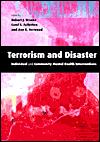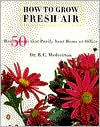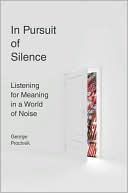Terrorism and Disaster: Individual and Community Mental Health Interventions
This follow-up book to Ursano et al.'s earlier title Individual and Community Responses to Trauma and Disaster expands the focus on terrorism. There is widespread belief among professionals that terrorism (and torture) produce the highest and most diffuse rates of psychiatric sequelae of all types of disaster. This book's international experts assess the lessons learned from the most recent atrocities. They look at prevention, individual and organizational intervention, the effect of...
Search in google:
Experts assess the lessons learned from the most recent terrorist atrocities in terms of psychiatric interventions and sequelae. Doody Review Services Reviewer:Daniel E. Levin, MD(Rush University Medical Center)Description:This review of mental health interventions following disasters with a special emphasis on terrorism is a follow-up to the authors' previous book, Individual and Community Responses to Trauma and Disaster: The Structure of Human Chaos (Cambridge University Press, 1994)Purpose:The goal is to examine commonalities and differences across disasters, with a special emphasis on individual and community responses and mental health interventions to terrorism. There is a great need for an updated book devoted to this topic. The editors and authors have succeeded in providing the field and community leaders with an all too timely and needed review of this subject.Audience:The book is written for professionals who work with trauma victims and help plan for disasters. Professionals from many different disciplines will find this book very helpful. The authors are undoubtedly the leading experts in the field. Features:The first major section includes reviews of the data and some first-hand accounts and "lessons learned" from leaders of responses to recent catastrophic acts of terrorism, such as the bombing of the U.S. embassy in Nairobi and 9/11. The next section is a compilation of chapters on acute interventions after a disaster for individuals and groups. The final section focuses on specific individual psychological responses and community responses to fears of exposure to contamination. Community leaders planning for disasters will appreciate the shared insights and experiences of leaders who led previous responses to terrorism. Readers will benefit from the assessment of the research on previous disasters that is clearly presented in the book. Additionally, the book includes a CD-ROM containing three, 50-minute PowerPoint presentations. The lectures cover an overview of psychiatric responses to disaster, debriefing, and working within federal disasters.Assessment:This is an essential resource for professionals seeking authoritative insight into individual and community mental health interventions after acts of terrorism and disaster. The book expands upon and updates the authors' previous book, specifically and necessarily focusing on the disaster of terrorism. The importance of a resource covering this topic cannot be overestimated. The authors have once again put together one of the most scholarly, pertinent, and useful books in the field.
List of contributorsPreface1Trauma, terrorism, and disaster12September 11, 2001 and its aftermath, in New York City233Leadership in the wake of disaster314Children of war and children at war: child victims of terror in Mozambique415The children of Oklahoma City586Individual and organizational interventions after terrorism: September 11 and the USS Cole717Applications from previous disaster research to guide mental health interventions after the September 11 attacks938A consultation-liaison psychiatry approach to disaster/terrorism victim assessment and management1079The role of screening in the prevention of psychological disorders arising from major trauma: Pros and cons12110Early intervention and the debriefing debate14611Clinical intervention for survivors of prolonged adversities12Collaborative care for injured victims of individual and mass trauma: A health services research approach to developing early intervention18913Responses of individuals and groups to consequences of technological disasters and radiation exposure20914Psychological effects of contamination: Radioactivity, industrial toxins, and bioterrorism23615Relocation stress following catastrophic events25916Population-based health care: A model for restoring community health and productivity following terrorist attack28717Traumatic death in terrorism and disasters: The effects on posttraumatic stress and behavior30818Terrorism and disasters: Prevention, intervention, and recovery333Index341
\ From The CriticsReviewer: Daniel E. Levin, MD(Rush University Medical Center)\ Description: This review of mental health interventions following disasters with a special emphasis on terrorism is a follow-up to the authors' previous book, Individual and Community Responses to Trauma and Disaster: The Structure of Human Chaos (Cambridge University Press, 1994)\ Purpose: The goal is to examine commonalities and differences across disasters, with a special emphasis on individual and community responses and mental health interventions to terrorism. There is a great need for an updated book devoted to this topic. The editors and authors have succeeded in providing the field and community leaders with an all too timely and needed review of this subject.\ Audience: "The book is written for professionals who work with trauma victims and help plan for disasters. Professionals from many different disciplines will find this book very helpful. The authors are undoubtedly the leading experts in the field. "\ Features: The first major section includes reviews of the data and some first-hand accounts and "lessons learned" from leaders of responses to recent catastrophic acts of terrorism, such as the bombing of the U.S. embassy in Nairobi and 9/11. The next section is a compilation of chapters on acute interventions after a disaster for individuals and groups. The final section focuses on specific individual psychological responses and community responses to fears of exposure to contamination. Community leaders planning for disasters will appreciate the shared insights and experiences of leaders who led previous responses to terrorism. Readers will benefit from the assessment of the research on previous disasters that is clearly presented in the book. Additionally, the book includes a CD-ROM containing three, 50-minute PowerPoint presentations. The lectures cover an overview of psychiatric responses to disaster, debriefing, and working within federal disasters.\ Assessment: This is an essential resource for professionals seeking authoritative insight into individual and community mental health interventions after acts of terrorism and disaster. The book expands upon and updates the authors' previous book, specifically and necessarily focusing on the disaster of terrorism. The importance of a resource covering this topic cannot be overestimated. The authors have once again put together one of the most scholarly, pertinent, and useful books in the field.\ \








